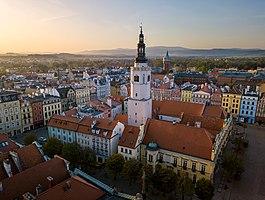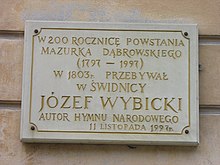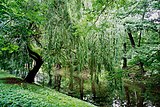Świdnica
Świdnica | ||
|---|---|---|
 Świdnica market square | ||
|
Car plates DSW | | |
| Website | http://www.um.swidnica.pl | |
Świdnica (Polish:
Świdnica is home to the
History
The city's name was first recorded as Svidnica in 1070, when it was part of
In 1291–1392 Świdnica was the capital of the
In 1429 the city successfully defended itself against a Hussite attack.[5] From about 1469 to 1490 it was under the rule of the Kingdom of Hungary and after that it was part of Jagiellonian-ruled Bohemia. In the 15th century, several mills operated in the city.[5] Large cattle and hop markets took place there.[5] In 1493, the town is recorded by Hartmann Schedel in his Nuremberg Chronicle as Schwednitz.[8]
In 1526 the city came under the rule of the

It was captured again by Austria in October 1761, during the Third Silesian War, or Seven Years' War, but Prussians retook it one year later. In 1803 the city was visited by Polish jurist, poet, political and military activist Józef Wybicki, best known as the author of the lyrics of the national anthem of Poland.[9] In 1807 the city was captured by French troops during the Napoleonic Wars. It became part of the Prussian-led German Empire in 1871 during the unification of Germany and stayed within Germany until the end of World War II. According to the Prussian census of 1905, the city of Schweidnitz had a population of 30,540 who were mostly Germans, but also included a Polish minority comprising around 3% of the population.[10] The World War I flying ace Lothar von Richthofen was buried in Schweidnitz, until the city became owned by Poland after World War II in which the graveyard was leveled. During World War I, the Germans operated a POW camp for Allied officers and a forced labour camp for regular POWs in the town.[11] A Nazi prison was located in the city under Nazi Germany,[12] and during World War II, the Germans also established a subcamp of the Gross-Rosen concentration camp, three prisoner of war labor divisions of the Stalag VIII-A camp and a forced labour camp.[7] Among the prisoners was Lesław Bartelski, Polish writer and resistance member, who fought in the Warsaw Uprising.[13] In January 1945, a German-perpetrated death march of Allied POWs from the Stalag Luft 7 passed through the city.[14]
After the defeat of
In 2004, Świdnica became the seat of the Roman Catholic Diocese of Świdnica.
Points of interest
The
The Evangelical Church of Peace, a UNESCO World Heritage Site and Historic Monument of Poland,[4] was built in 1656–57.

The 16th-century town hall has been renovated numerous times and combines Gothic, Renaissance, and Baroque architectural elements. A museum is located in the town hall. The Baroque Church of St. Joseph and the Church of St. Christopher are from the same era. One remaining element of the former defensive works is the Chapel of St. Barbara.
Other notable destinations include the old town and the Stary Rynek square,

Politics
Wałbrzych constituency
Members of Parliament (
| Michał Dworczyk | Law and Justice
|
| Marek Dyduch | Democratic Left Alliance |
| Marcin Gwóźdź | Law and Justice
|
Izabela Mrzygłocka
|
Civic Platform |
| Wojciech Murdzek | Agreement |
| Tomasz Siemoniak | Civic Platform |
| Monika Wielichowska | Civic Platform |
| Ireneusz Zyska | Law and Justice
|
Education
Świdnica is home to a College of Data Communications Technology (Wyższa Szkoła Technologii Teleinformatycznych).
In 2003, Świdnica hosted a session of the Warsaw-based International Chapter of the
Sport
- Polonia Świdnica – football club that competes in the lower leagues, but also played in the Polish second division in the 1940s and 1950s.
- Akademia Piłkarska 13 Jarosława Lato
Notable people
- Thomas Stoltzer (c. 1480–1526), composer
- Maria Cunitz (1604–1664), astronomer
- Benjamin Schmolk(1672–1737), composer, poet
- Johann Christoph Glaubitz (c. 1700–1767) architect
- Johann Gottlieb Janitsch (1708–1763), composer
- Karl Theodor Robert Luther (1822–1900), astronomer
- Albert Kretschmer (1825–1891), professor, painter, costumes researcher
- Clara Jaschke (either 1848 or 1858 - 1912) one of Prussia and Germany's first women railway workers and campaigner for women's rights.
- Emil Krebs (1867–1930), sinologist
- Ferdinand Friedensburg (1886–1972), politician
- Michael Graf von Matuschka(1888–1944), resistance fighter
- Hubert Schmundt (1888–1984), Kriegsmarine Admiral
- Manfred von Richthofen (1892–1918), World War I ace known as "The Red Baron"
- Peter Adolf Thiessen (1899–1990), physical chemist
- Heinz Starke (1911–2001), politician, Bundesfinanzminister 1961–1962
- Georg Gärtner(1920–2013), known as "Hitler's last Soldier in America"
- Gunther Gebel-Williams (1934–2001), animal trainer
- Manfred Kanther (born 1939), politician
- Henning Eichberg (born 1942), cultural sociologist
- Dorota Świeniewicz (born 1972), volleyball player, member of Poland women's national volleyball team
- Bartosz Huzarski (born 1980), cyclist
- Anna Werblińska (born 1984), volleyball player, member of Poland women's national volleyball team
- Janusz Gol (born 1985), Polish professional footballer
- Arkadiusz Piech (born 1985), Polish professional footballer
- Patryk Klimala (born 1998), Polish professional footballer
- Aleksander Balcerowski (born 2000), basketball player
Gallery
-
Świdnica Town Hall
-
St. Stanislaus and St. Wenceslaus Cathedral
-
Dom pod bykami (House under the bulls)
-
Saint Joseph's Church
-
Historic townhouse at the market square
-
Historic townhouse at the market square
-
City Park
Twin towns – sister cities
- Biberach an der Riss, Germany
 Ivano-Frankivsk, Ukraine
Ivano-Frankivsk, Ukraine Kazincbarcika, Hungary
Kazincbarcika, Hungary Nizhyn, Ukraine
Nizhyn, Ukraine Police nad Metují, Czech Republic
Police nad Metují, Czech Republic Švenčionys, Lithuania
Švenčionys, Lithuania Trutnov, Czech Republic
Trutnov, Czech Republic Tendring, United Kingdom
Tendring, United Kingdom
Notes
References
- ^ a b "Local Data Bank". Statistics Poland. Retrieved 18 August 2022. Data for territorial unit 0219011.
- ^ Press release, Siedem nowych gmin w Aglomeracji Wałbrzyskiej. Swidnica24.pl. Retrieved 23 February 2014.
- ^ a b Rozporządzenie Prezydenta Rzeczypospolitej Polskiej z dnia 15 marca 2017 r. w sprawie uznania za pomnik historii "Świdnica - katedra pod wezwaniem św. Stanisława Biskupa i Męczennika i św. Wacława Męczennika", Dz. U. z 2017 r. poz. 655
- ^ a b Rozporządzenie Prezydenta Rzeczypospolitej Polskiej z dnia 15 marca 2017 r. w sprawie uznania za pomnik historii "Świdnica - zespół kościoła ewangelicko-augsburskiego pod wezwaniem Świętej Trójcy, zwany Kościołem Pokoju", Dz. U. z 2017 r. poz. 672
- ^ a b c d e f g h "Historia Świdnicy". UM Świdnica (in Polish). Retrieved 25 November 2019.
- ^ Czerwiński, Janusz; Chanas, Ryszard (1977). Dolny Śląsk – przewodnik (in Polish). Warszawa: Sport i Turystyka. pp. 178–186.
- ^ a b c d "Świdnica". Encyklopedia PWN (in Polish). Retrieved 25 November 2019.
- ^ See Die Schedelsche Weltchronik on German Wikisource.
- ^ "220 lat Mazurka Dąbrowskiego. Jak właściwie śpiewać Hymn Polski?". Swidnica24.pl (in Polish). 20 July 2017. Retrieved 1 November 2020.
- ISBN 978-3-87969-267-5.
- ISSN 0137-5199.
- ^ "Gefängnis Schweidnitz". Bundesarchiv.de (in German). Retrieved 1 November 2020.
- Wyższej Szkoły Pedagogicznejw Krakowie: 53.
- ISSN 0137-5199.
- ^ Kubasiewicz, Izabela (2013). "Emigranci z Grecji w Polsce Ludowej. Wybrane aspekty z życia mniejszości". In Dworaczek, Kamil; Kamiński, Łukasz (eds.). Letnia Szkoła Historii Najnowszej 2012. Referaty (in Polish). Warszawa: IPN. p. 117.
- ^ "Miasta partnerskie". um.swidnica.pl (in Polish). Świdnica. Retrieved 2020-03-03.
External links
- Website of the municipality of Świdnica
- Jewish Community in Świdnica on Virtual Shtetl
- Peace Church Panoramic view
![]() Media related to Świdnica at Wikimedia Commons
Media related to Świdnica at Wikimedia Commons
- Chisholm, Hugh, ed. (1911). . Encyclopædia Britannica (11th ed.). Cambridge University Press.








